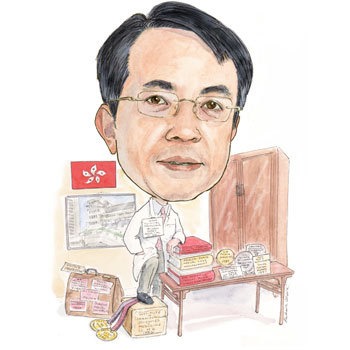
Chu-Pak Lau, honorary clinical professor, Division of Cardiology, Department of Medicine, University of Hong Kong, Queen Mary Hospital, Hong Kong, talked to Cardiac Rhythm News about rate-responsive pacemakers, the potential role of gene therapy in managing atrial fibrillation, and leadless pacing.
Why did you decide to become a doctor and, in particular, why did you choose to specialise in the management of cardiac arrhythmias?
When I was young, in Hong Kong, there were three prestigious occupations: medicine, architecture, and law. I chose medicine because I thought this would be the most direct way of helping people. I did not choose arrhythmology-it was chosen for me! At the time, my boss was Dr Rebecca Wang, who studied arrhythmology and wanted someone to “follow in her footsteps”. She chose me! I suppose I was not doing so badly as a cardiac fellow then!
In terms of your career, who has been your greatest inspiration and why?
During my training as an electrophysiologist, I worked with Professor John Camm at St George’s University of London, UK. He was my mentor and gave me direction in what was new and what I should focus on. I had a lot of freedom at St George’s to do what I wanted to do and I learnt a lot in the process. There was also Dr David Ward and, on the research side, there was Dr Ghazwan Butrous. He taught me to evaluate clinical problems in a scientific way.
What do you feel has been your biggest contribution to medicine?
I think I made “my mark” by contributing to the development of rate-responsive pacemakers. Prior to the development of rate-responsive pacemakers, pacemakers could only pace at a fixed rate and that had obvious limitations. When people exercise or they are under emotional stress, they have a higher heart rate than those who are at rest, and have different physiological needs. Therefore, I was involved in developing and evaluating “sensors” on pacemakers that would increase heart rate according to physiological demands. Some of these sensors are incorporated into standard pacemakers. Furthermore, sensors have also been used to monitor heart failure.
What has been your most memorable case and why?
There are several, but I think first time we used radiofrequency catheter ablation was a memorable case. It was very early days for catheter ablation-so, it would have been around 1991-and my cath lab in Hong Kong was only one of a few that were performing catheter ablation at the time. I remember it was a patient who had cardiac arrest with rapid atrial fibrillation due to Wolff-Parkinson-White syndrome. It took us nine hours to complete the ablation, and the procedure was both frustrating and rewarding. We were happy because the ablation was successful.
At HeartRhythm 2012, you presented trial data from a study that found black patients are significantly less likely to develop atrial fibrillation than white Europeans. What are the potential reasons for this finding?
The study [based on data from ASSERT, Asymptomatic atrial fibrillation and stroke evaluation in pacemaker patients and the atrial fibrillation reduction atrial pacing trial] involved different racial groups living in 23 countries in North America, Europe and Asia. We found that in patients with hypertension without a history of atrial fibrillation, black African, Chinese and Japanese people have a lower incidence of new onset atrial fibrillation than patients of European ethnic origin, as recorded using an implanted pacemaker or an implantable cardioverter defibrillator (ICD).
In the case of black Africans, the incidence of atrial fibrillation is at least 50% lower despite a higher prevalence of risk factors for atrial fibrillation. This study is unique as atrial fibrillation episodes were captured with implanted cardiac devices, thus allowing registration of both silent and paroxysmal atrial fibrillation. Importantly, this removed ascertainment bias that has been reported in some ethnic group such as access to medical care. Therefore, I think there is a genetic basis for the difference.
Also, there are some observational reports that if a parent develops atrial fibrillation before the age of 75 years, their offspring had a 3.2 fold increased risk of developing atrial fibrillation themselves compared with people whose parents did not develop the condition before the age of 65. Therefore, again, this indicates that genes may have some role in the development of atrial fibrillation. Now that we have data that genetic differences between populations do exist, we have a very strong background to do more research into these differences and identify which gene(s) predispose white Europeans to develop more arrhythmias than black people.
As someone who has worked in the UK and in Hong Kong, does the Asian approach to the management of cardiac arrhythmias differ from the Western approach?
Hong Kong (a British colony until 1997) has a background in British education, especially medicine. Therefore, I think the way we manage arrhythmias is very similar to the UK. However, the patients are different; Chinese people tend to be more tolerant of symptoms than British people and they are not as willing to undergo surgical procedures. I think the reason for this is probably cultural.
At HeartRhythm 2012, you also spoke about “Leadless pacing: an upcoming reality.” What is leadless pacing and is it an “upcoming reality”?
Current pacemakers still have to be implanted into a “pocket” underneath the skin, they have leads, and they still have a connector, and this means that they have some limitations. For example, the pocket may restrict movement, pacemaker implantation can be difficult, and there are lead infections. Therefore, there must be a better way to design pacemakers-especially as we now have the technology to produce miniaturised devices, batteries, and delivery systems. Potentially, we can reduce all of these items into much smaller devices so that a pocket is not required.
There are several ways that leadless pacing is being evaluated, one of which to put the whole pacemaker and lead together in a small capsule inside heart and this is close to being tested in humans. At least two companies are looking at it. However, the problem with this type of leadless pacing is that it might be too bulky. There are also studies evaluating the idea of just having the electrode of the pacemaker inside the heart.
These can be very small, but they do need an energy source from outside, which could be done with ultrasound, radiofrequency or electromagnetic induction. There is research on using ultrasound as the energy source to pulse the pace inside of the heart in animal studies and there are early human studies as well. Finally, it may be possible to capture the energy of heart contraction, so you have a self-powered device.
You are the past president of the International Cardiac Pacing and Electrophysiology Society (ICPES; now, The World Society of Arrhythmias), what were your goals as president and how did you set out to achieve them?
The goal of the World Society of Arrhythmias is mainly bringing education to physicians and patients on a worldwide basis. It is highly devoted to education. In order to do this, a meeting is held every four years. We have an international pacing registry, and we are liaising with international arrhythmology societies and patient groups to achieve our goal.
In these economically difficult times, finding the money to attend international medical conferences can be difficult. Why in your view is it important to attend such conferences?
The benefit of attending medical conferences is that you can focus on learning. While you can read medical texts at home, your time is less protected and there are distractions. Also at meetings, you can have face-to-face interaction with speakers and learn about the most important medical advances that are happening in the world. I think meetings will continue, but it may just be the bigger international meetings.
What has been the most interesting research paper you have come across in the past year?
There have been so many interesting papers that I find it difficult to choose just one. But, I think in terms of publications that have changed my practice, the introduction of newer antithrombotics for the prevention of stroke in patients with atrial fibrillation instead of warfarin has had an impact. This has changed the way we practise medicine and the patients are much happier.
What should the priorities be for research in the field of cardiac rhythm management?
I think there are several areas. We have now reached a plateau in the last two or three years in the way we have managed arrhythmias. For ablation of atrial fibrillation, for instance, we have seen that new technological devices do not necessarily give us a quantum jump in the success rate of ablation. They make the procedure easier, faster, and less complicated but we still do not have a 100% success rate. This may be because we do not understand the mechanism of atrial fibrillation fully; therefore, we need more research into this area.
Also, while cardiac resynchronisation therapy (CRT) is beneficial in many patients with heart failure, up to 30% of patients do not respond to it.
Therefore, research should focus on non-responders. Additionally, we do not have appropriate therapy for patients with heart failure without left bundle branch block or preserved left ventricular ejection fraction. We may find that they need other therapies as well as electrical. I would like to see breakthroughs in this area.
Outside of medicine, what are you hobbies and interests?
My main interest is studying antique furniture. The act of collecting is a joy in itself. This is particularly so if through my knowledge of such antiques, I can find and acquire a piece at a reasonable price that other people have missed. The Ming style furniture is made from precious hard wood, and characterised by simplicity in design and construction. In addition to the visual attraction, I am interested in researching how furniture was used in the past in relation to social and cultural situations at the time, ie each piece of furniture can tell you a story. Finally, unlike most types of antiques that you can only look or at most touch, the Ming furniture has stood the test of time and remained functional. You can actually sit on it!
Fact File
Current professional appointments (selected)
Honorary clinical professor, Department of Medicine, Queen Mary Hospital, University of Hong Kong, Hong Kong Education
Specialist in internal medicine
Specialist in cardiology
Specialist in critical care medicine
1989 MD, The University of Hong Kong, Hong Kong
1985 MRCP, UK
1981 MBBS, The University of Hong Kong, Hong Kong
Awards (selected)
2003 Secretary general of 2003 International Conference of Pacing and Electrophysiology
1997 Ten Most Outstanding Young Person Award
Societies
2013 Chairman, the joint Asian Pacific Heart Rhythm Annual meeting and CardioRhythm
The Hong Kong College of Cardiology (past president)
Heart Rhythm Society (member of International Advisory Council, Council of IBHRE exam board)
European Working Group on Cardiac Pacing
British Pacing and Electrophysiology Group
World Society of Arrhythmias/ The International Cardiac Pacing and Electrophysiology Society (immediate past president)












